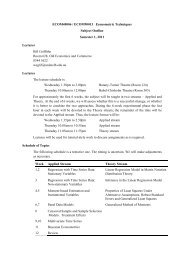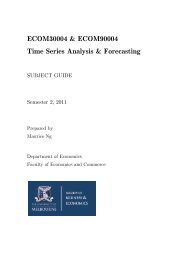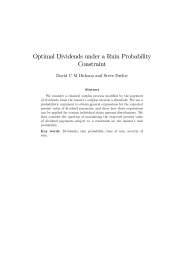A Model of Optimal Corporate Bailouts - Faculty of Business and ...
A Model of Optimal Corporate Bailouts - Faculty of Business and ...
A Model of Optimal Corporate Bailouts - Faculty of Business and ...
You also want an ePaper? Increase the reach of your titles
YUMPU automatically turns print PDFs into web optimized ePapers that Google loves.
constraints, <strong>and</strong> budgetary constraints. Each <strong>of</strong> these constraints warrants a brief discussionbefore we formally state the design problem.The first set <strong>of</strong> constraints concerns incentive compatibility: Both the manager’s <strong>and</strong> thefirm’s strategies (Σ m <strong>and</strong> Σ f , respectively) must be part <strong>of</strong> a Bayesian-perfect equilibrium,so that they choose strategies that maximize their expected pay<strong>of</strong>fs—M( Σ|Ω ) <strong>and</strong> Π( Σ|Ω ),respectively, where M is managerial utility <strong>and</strong> Π is corporate pr<strong>of</strong>it—at every continuationgame, given their beliefs. 11 In addition, we require that the government’s strategy Σ G mustalso be part <strong>of</strong> a Bayesian perfect equilibrium. Given that the government is presumed tomaximize SV (·), this is functionally equivalent to assuming that the government has limitedability to commit <strong>and</strong> thus maximizes social welfare at each continuation stage. More formally,if Γ( SV (·), M(·), Π(·), Σ, Ω ) denotes the game established by our framework, <strong>and</strong> B( Γ ) denotesthe Bayesian perfect equilibria <strong>of</strong> Γ, incentive compatibility requires that Σ 1 , Σ 2 , Σ 3 ∈ B( Γ ).The second set <strong>of</strong> constraints concerns participation by the firm <strong>and</strong> the manager. Werequire that under the optimal bailout plan, the firm is still willing to invest, <strong>and</strong> the manager isstill willing to work for the firm. Thus, we require both parties to achieve expected pay<strong>of</strong>fs thatexceed their reservation utilities (which we normalize at zero). Formally, individual rationalityrequires that both M ( Σ|Ω ) ≥ 0 <strong>and</strong> Π ( Σ|Ω ) ≥ 0.The third constraint concerns budgetary feasibility. Specifically, we require that the bailoutprogram achieves actuarial budget balance, so that the expected tax received by the government(through T 1 <strong>and</strong> T 2 ) can finance the expected bailout costs. 12 In effect, the actuarial budgetbalance requirement constitutes the government’s de facto participation constraint. Formally,actuarial budget balance requires thate 1·T 1 + 1 − e 1 · e2·T 2 − g ≥ 0 .The optimal bailout design problem can now be stated formally asmax SV ( Σ|Ω ) (3)〈Σ m ,Σ f ,Σ G〉subject to: (IC) : Σ m , Σ f , Σ G∈ B( Γ )(IR) : M( Σ|Ω ) ≥ 0; Π( Σ|Ω ) ≥ 0(BB) : e 1·T 1 + 1 − e 1 · e2·T 2 − g ≥ 0where (IC), (IR), <strong>and</strong> (BB) are the incentive, participation, <strong>and</strong> budget-balance constraints.11 For the exposition here, we slightly abused notation by not differentiating between the period-2 strategies/pay<strong>of</strong>fs<strong>of</strong> the retained manager <strong>and</strong> those <strong>of</strong> her replacement (if the incumbent is fired). This is withoutloss <strong>of</strong> generality, because the incumbent <strong>and</strong> replacement cases are mutually exclusive, <strong>and</strong> because they faceidentical continuation pay<strong>of</strong>fs / strategies as <strong>of</strong> period 2. That said, we are careful to distinguish in what followshow the retention <strong>of</strong> the incumbent affects her first period behavior.12 The assumption that the government actuarially balances its budget (instead <strong>of</strong> on a firm-by-firm basis) isnatural. The government regulates an entire population <strong>of</strong> firms <strong>and</strong> balance budgeting is a condition that holdsin the aggregate. Actuarial budget balancing is only the per-firm analog <strong>of</strong> an aggregate budget-balance condition.11
















